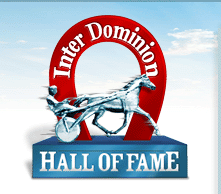 |
 |
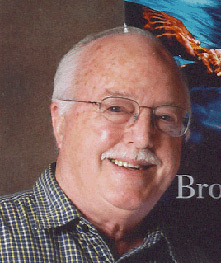 |
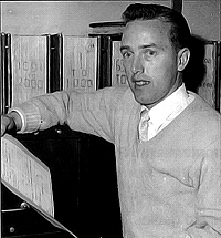 |
Ken Dyer, soon after being appointed NSW Registrar. As assistant
time-keeper, he was holding the stopwatch on each of the nights
Avian Derby, Ribands and James Scott became Australia’s first
2:00 pacers
photo courtesy Max Agnew
|
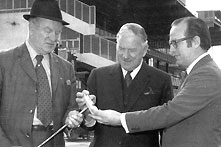 |
Gloucester Park 1975: Laurie Collins, Registrar WATA, Sir Frank Ledger, President, Aust Harness Racing Council, and Ken Dyer, CEO Aust Harness Racing Council
photo courtesty "Track Bred", Autumn 2007
|
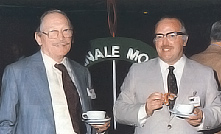 |
Representing Macau at the 1981 World Trotting Conference in
Rome, Ken Dyer shares a cup of tea with Lord Langford,
representing Great Britain
photo courtesy Max Agnew |
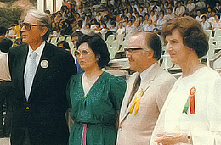 |
Ken and Betty Dyer, pictured with Gregory Peck and prominent
local racing personality Lori Yip at the Macau track. Film stars
from Hollywood were brought to Macau for promotion of the new
sport there.
photo courtesy Max Agnew |
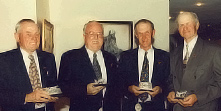 |
After receiving Harness Racing Victoria’s Meritorious Service
Award in 1997
Ken Dyer (second from left) is pictured with Jim Roberts, Les
Pratt and Ian McCallum |
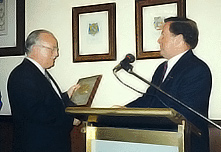 |
|
Receiving the Inter Dominion Gold Medal from the then AHRC &
IDHRC President, Dr Ern Manea |
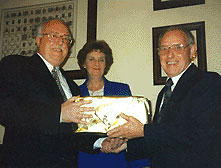 |
|
Ken and Betty Dyer, with Ray Holloway (WATA), at Ken’s Retirement Dinner 1997 |
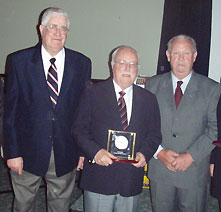 |
|
Ken (centre) with VSBA President, Stan Rutland (left), and Treasurer, Des McQueen (right) after receiving his 2008 VSBA Award |
|
 |
 |

CAREER INDUSTRY ADMINISTRATOR AND WRITER
Born Kenneth John Dyer in 1932 at Oatley, NSW, a southern suburb
of Sydney, Ken Dyer came into harness racing in 1947 as an
office junior with the NSW Trotting Club (NSWTC) then in the CBD
of Sydney.
The Secretary of the Club at that time was Norman Hollier who
became Dyer’s mentor over the next two decades. Hollier had
started as an office junior in 1918 and had risen to Secretary
in 1940. He later became Secretary to the Inter Dominion
Trotting Council (IDTC) from 1956 to 1964.
In late 1948 the NSWTC was granted a night trotting licence and
in the ensuing impetus in breeding and registration of horses
the Club transferred some of its departments to Harold Park
including the Registration Department to which Dyer was
seconded.
By 1953 at twenty one years of age he had been appointed
Registrar of the NSWTC and shortly afterwards was elected in a
dual capacity as Honorary Secretary of the Trotting Horse
Breeders Association of NSW (now called NSW Breeders and
Studmasters Association) under President Jack Raith.
These two positions enabled him to become extremely well known
to breeders, owners and studmasters throughout NSW. In addition
on race nights at Harold Park he was in charge of the public and
members office and was assistant timekeeper. On racedays at
Menangle Park under the control of NSWTC he was the acceptance
clerk, timekeeper and assistant judge.
During this decade Dyer met various Interstate and New Zealand
dignitaries at Inter Dominion Championships Carnivals at Harold
Park and assisted Joe Butler, the first full time Secretary of
the Inter Dominion Trotting Council (IDTC), in compiling the
first national Stud Book published in 1955. To fit in with
information required for the Stud Book Dyer upgraded the NSWTC
registration infrastructure to allow easy access to sires and
brood mares records at the stud and correlated this detail with
their racing performances.
In 1956 Norman Hollier succeeded Joe Butler as Secretary of the
IDTC and in 1957 organized the first IDTC Registrars and Stud
Book Conference in Adelaide. Representing the NSWTC Dyer put
forward an initiative which was adopted calling for all State
controlling bodies to provide uniform rules and infrastructure
for sire registration, foal notification, naming of horses and
stud book entry in the same manner as existed in NSW and SA.
This was a huge step forward as the other States had been slow
to move.
In 1962 the position of Secretary of the newly created Tasmanian
Trotting Association was advertised and Ken Dyer was appointed
to the position in Launceston. Not an easy position to
administer where the previous North and South Trotting Clubs and
Associations were in conflict with the new body he had an
opportunity to start from scratch and bring in new registration,
breeding and racing rules which startled Tasmanian reinsmen,
owners, breeders and studmasters who had been used to going
about their business in a free handed manner.
During this time he had the support of Harold Nevin the Chairman
of the new Association and Arthur Neilsen then Commissioner for
gambling and racing in Tasmania. Arthur Neilsen had originally
been the handicapper/registrar in New Zealand in the 1940’s but
had been seconded in 1950 by JP Stratton President of the IDTC
to draft the first Reciprocal Handicapping System. Stratton at
that time had visions of creating an Australian national body to
control the Stud Book, Registrar of Names, Handicapping, and
National Rules of Racing. He also had in mind that Arthur
Neilsen would have been the ideal person for the purpose of
administration but Neilsen went to Tasmania instead.
Whilst in Tasmania, Dyer convinced the Association that it
should join the IDTC and give Tasmania a voice in the making of
national rules and where the mainland States might give
concessions for the handicapping of Tasmanian horses when
travelling to the mainland. The Tasmanian Trotting Association
was accepted into the Council in 1963 and eventually came to
race the Inter Dominion Championships in 1980 when funding
became available through substantial B.P. sponsorship organized
by the IDTC.
In 1964 Norman Hollier died and Ken Dyer was appointed to his
position as IDTC Secretary. His first tasks were to simplify the
naming records and to continue uniformity work on the national
Rules of Trotting but priority was to be given to revitalizing
the Stud Book archives to bring them up to the standard of the
North American publications. Realising the problem was a
combination of funding shortages and the lack of a data base of
sires records and progeny, foalings and names, and race
performances of each horse, he had to coordinate a new way of
collecting information and a way to update such information.
After two years with assistance from each State, Dyer had
established a data base of brood mare records and race
performances of all horses as far back as State records would
allow. The winning performers were assigned to their respective
sires from which base the performers could be listed with their
best winning performances and the progeny of mares could be
cross matched.
At the same time it was realized that to secure funds for
publication of the Stud Book it would be necessary to
restructure and to impose annual fees on sires, mares, foals and
naming of horses.
In 1966 Dyer recommended that Australia needed a Year Book to
record historical racing data for posterity and this would also
allow the Stud Book records to be updated annually. This was
agreed by the IDTC and as a result the first IDTC national Year
Book was published in 1968 and continued to 2001 when
discontinued by the Australian Harness Racing Council.
In 1969 the IDTC received an invitation from the United States
Trotting Association to attend the 1st World Trotting Conference
in Columbus, Ohio, and Ken Dyer was appointed by the Council to
attend on its behalf whilst Len Smith of the NSWTC represented
that body. Thirteen national bodies were represented at the
Conference.
Coming back from North America after the Conference with many
ideas, Dyer reported on new discoveries and methods of
freezebranding of horses by Swedish Professors at Cornell
University. He also gave a report on a code which could be
adapted to freeze branding - the code having being developed by
the Washington State University. He proposed to Council that the
two developments combined would give Australia a great
opportunity to identify without error the entire trotting horse
breed in Australia. The code could be recorded in the Stud Book
and it would replace the inhumane hot iron branding.
Additionally it could be read by officials and breeders and
owners alike at racecourses and on stud farms to identify mares
and foals etc. This was agreed by the IDTC and its members
individually.
Out of this Conference came another initiative put forward by
Stanley Bergstein for a World Driving Championship each two
years and which has continued to the present time. The World
Conference delegates also examined the work being done by the
United States Trotting Association to develop mobile drug
laboratories that would travel around the various tracks to test
horses starting thereat. Dyer was interested in the USTA’s
microfilm records as well, but was told by officials that the
technology would be outdated within a decade by development of
computers.
Another issue which had its genesis at the1969 World Conference
was the fact that Australia was not represented as an individual
country but only as a member of the IDTC. This was far from
satisfactory as Dyer considered that there should be an
Australian national body to promote its racing and its horses
internationally. This initiative was first put forward by Dyer
at the 1970 meeting of the IDTC. Initially the reception was
lukewarm, however, with persistence, the Australian Trotting
Council (later Australian Harness Racing Council) was formed in
1974 as a separate incorporated body with Ken Dyer operating as
the dual Secretary of the IDTC and ATC.
Works in progress within the IDTC umbrella were transferred to
the ATC; the freeze branding program, the Stud Book and Year
Book and other projects were part of the new body’s charter, and
opportunity to start off with a wish list of initiatives was
never greater. Marketing and promotion developments included an
awards system for horse categories and for reinsmen and
administrators. In addition the new body, to encourage greater
publicity in the media, created awards for current and
historical articles, stories, and books. The names of prominent
horses and notable trotting personnel were attached to each
award.
In 1979 the IDTC, ATC and the NZTC combined to conduct that
year’s World Driving Championship throughout New Zealand and
Australia finishing in Perth at the same time as the World
Trotting Conference was convened. Ken Dyer was appointed General
Secretary of the International Trotting Association (ITA) to
serve a term of two years from 1978-1979 inclusive with
authority to organize the Driving Championship and the
Conference.
Shortly after completion of his duties in connection with the
ITA Ken Dyer took up the position of General Manager of the
Macau Trotting Company on a contractual basis for two years
commencing January 1980. The proposed track on the island of
Taipa was in the nature of an experiment as trotting in Asia was
unknown.
Realising on arrival in Macau there was no finish date for the
works, he set a time frame and plan for completion of
Grandstand, Racetrack, Stables and Veterinary areas, ready for
an inaugural meeting in August 1980. The infrastructure of the
Macau Trotting Company and Macau Trotting Club had to be drawn
up, and Racing Rules to be completed within the same timeframe.
By April 1980 the trainers, assistants, and their families had
arrived and accommodation found, and 500 horses purchased in
Australia and New Zealand were shipped in two tranches. Other
incidental matters involving a reliable supply of feed were
arranged in Australia, California and Thailand. Sulkies and gear
were purchased in Australia. But by far the most difficult
problem was the development of veterinary services. Generally
trainers in their homelands were responsible for the health of
their horses, however, in Macau the Company owned the horses and
were duty bound to establish rules for medication and stable
care.
This caused some problems for the trainers used to independent
action but a system was developed that allowed for morning and
evening veterinary service and the administration of medication,
as trainers were not personally permitted to carry out these
procedures.
At its opening the Macau Racetrack on Taipa Island was said to
be the most modern in the world costing the owner forty two
million US dollars to achieve his dream.
Returning to Australia in December 1981 Ken was appointed
Secretary to the Bankstown District Agricultural and Trotting
Society which conducted harness racing on its Bankstown Paceway.
He returned to Melbourne in early 1985 to take up a position
with Harness Racing Victoria specifically to edit and upgrade
its monthly magazine “Harness Racer” shortly after becoming
Board Secretary to the Chief Executive Officer Dr Phillip Swan.
In 1986 Ken Dyer’s previous positions with the AHRC and IDTC
became vacant and he was appointed to his old positions. In the
six years he had been away the Council’s technology had been
developed substantially and the computerization of records which
he had started in 1969 had gone a long way towards establishment
of better record keeping. Blood typing had been introduced by
the AHRC in the early 1980’s but Dyer foresaw that newly
developed DNA techniques would be ideal for the harness racing
industry and after its introduction Australian harness racing
became the first horse racing code in the world to use DNA
technology.
Ken Dyer was married to Betty Arnold at South Hurstville, NSW,
in 1961 having three children - Graeme born in Launceston,
Tasmania, Geoffrey and Trudy were born in Melbourne, Victoria.
Retiring in 1997 after fifty years in harness racing Ken Dyer
was awarded the Inter Dominion Gold Medal for significant
achievements to the harness racing industry whilst the
International Trotting Association awarded him Life Membership
for his services on a global scale.
Since retiring Ken has won several AHRC Literary Awards for stories about harness racing people, horses and events, and further recognition came in 2008 with a Distinguished Service Award from the Victorian Standardbred Breeders and Studmasters Association.

|
|